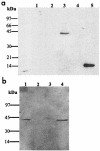Recombinant Mycobacterium bovis BCG expressing the Sm14 antigen of Schistosoma mansoni protects mice from cercarial challenge
- PMID: 15155638
- PMCID: PMC415698
- DOI: 10.1128/IAI.72.6.3336-3343.2004
Recombinant Mycobacterium bovis BCG expressing the Sm14 antigen of Schistosoma mansoni protects mice from cercarial challenge
Abstract
The Sm14 antigen of Schistosoma mansoni was cloned and expressed in Mycobacterium bovis BCG as a fusion with the Mycobacterium fortuitum beta-lactamase protein under the control of its promoter, pBlaF*; the protein was localized in the bacterial cell wall. The rBCG-Sm14 strain was shown to be relatively stable in cultured murine and bovine monocytes in terms of infectivity, bacterial persistence, and plasmid stability. The immunization of mice with rBCG-Sm14 showed no induction of anti-Sm14 antibodies; however, splenocytes of immunized mice released increased levels of gamma interferon upon stimulation with recombinant Sm14 (rSm14), indicating an induction of a Th1-predominant cellular response against Sm14. Mice immunized with one or two doses of rBCG-Sm14 and challenged with live S. mansoni cercaria showed a 48% reduction in worm burden, which was comparable to that obtained by immunization with three doses of rSm14 purified from Escherichia coli. The data presented here further enhance the status of Sm14 as a promising candidate antigen for the control of schistosomiasis and indicate that a one-dose regimen of rBCG-Sm14 could be considered a convenient means to overcome many of the practical problems associated with the successful implementation of a multiple-dose vaccine schedule in developing countries.
Figures





References
-
- Abdelhak, S., H. Louzir, J. Timm, L. Blel, Z. Benlasfar, M. Lagranderie, M. Gheorghiu, K. Dellagi, and B. Gicquel. 1995. Recombinant BCG expressing the leishmania surface antigen Gp63 induces protective immunity against Leishmania major infection in BALB/c mice. Microbiology 141:1585-1592. - PubMed
-
- Aldovini, A., and R. A. Young. 1991. Humoral and cell-mediated immune responses to live recombinant BCG-HIV vaccines. Nature 351:479-482. - PubMed
-
- Aldwell, F. E., D. N. Wedlock, L. J. Slobbe, J. F. Griffin, B. M. Buddle, and G. S. Buchan. 2001. In vitro control of Mycobacterium bovis by macrophages. Tuberculosis (Edinburgh) 81:115-123. - PubMed
-
- Bergquist, N. R. 1998. Schistosomiasis vaccine development: progress and prospects. Mem. Inst. Oswaldo Cruz 93(Suppl. 1):95-101. - PubMed
Publication types
MeSH terms
Substances
LinkOut - more resources
Full Text Sources
Other Literature Sources

